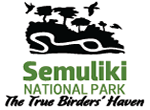The canopy maintains a relatively closed structure with high humidity and minimal light penetration.
It is important to note that rainfall averages 1,250 millimetres annually, sustaining evergreen conditions throughout the year.
Canopy stratification is evident. The upper layer comprises emergent hardwoods, followed by a mid-layer rich in understorey trees such as Diospyros and Pseudospondias.
The lowest level contains herbs, ferns, and young saplings. Epiphytes occupy the trunks, while mosses and lichens mark older trees, indicating long-term stability.
The canopy regulates the park’s microclimate by controlling evapotranspiration and reducing surface runoff. In addition, it provides continuous food resources for primates and birds that rarely descend to the ground.
Research teams often note the presence of canopy-dwelling insects and reptiles that are rarely documented elsewhere in Uganda.
Walking beneath this canopy gives a clear impression of vertical complexity. Light filters through narrow openings, revealing layers of vegetation above.
The air is consistently humid, and sound travels slowly through the tree columns. It may appear quiet, but a trained ear detects insects, frogs, and distant primate calls. It is, in its way, a self-sustaining acoustic system.
The rainforest canopy of Semuliki functions as the park’s ecological backbone, maintaining equilibrium across the entire habitat.
